Discover the goodness of homegrown sprouts! Learn how to easily sprout beans and legumes for added nutrition and flavor. Perfect for salads, wraps, and more.
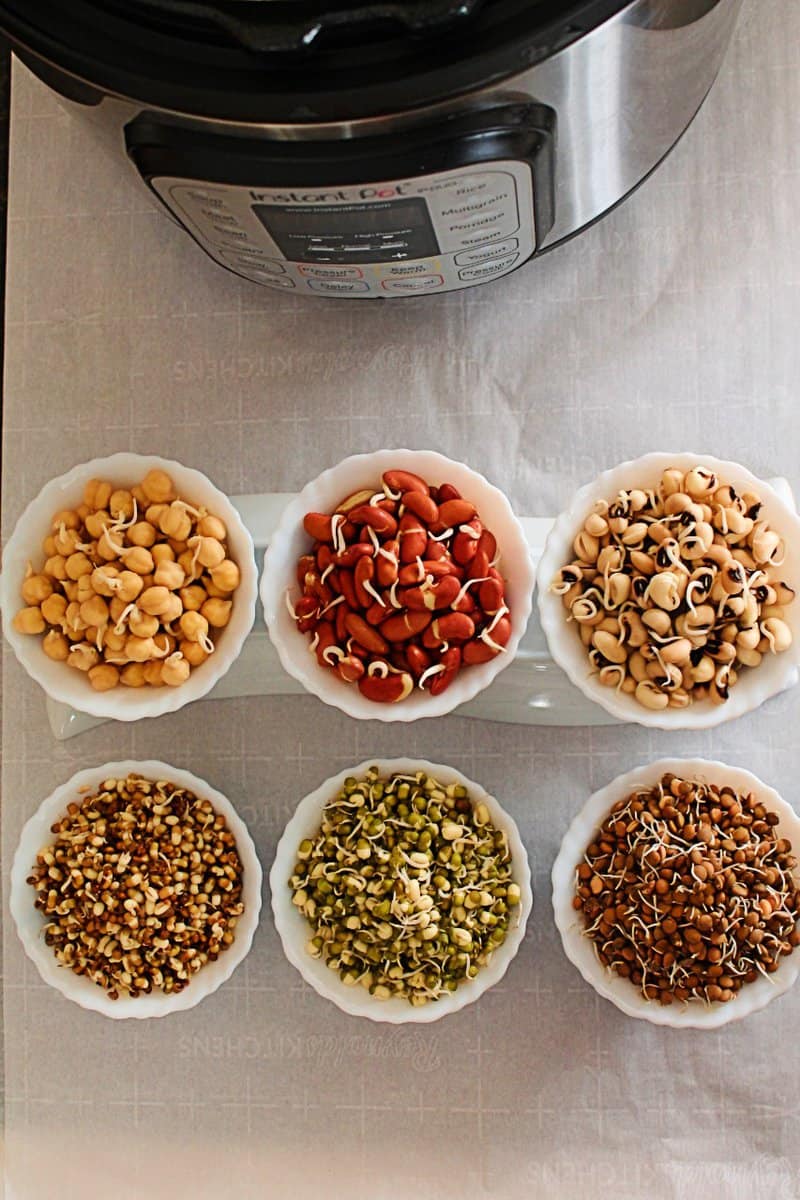
Sprouting beans is a simple and nutritious way to enjoy legumes in their early stages of growth. Sprouted beans are known to have increased nutrient content and are easier to digest compared to their unsprouted counterparts.
Sprouts are nutritious and easy to grow at home. They are consumed around the globe in many cuisines, in many different ways. Sprouts can be added to soups, salads, curries, stir-fries, and wraps.
In India, growing sprouts at home are quite common. Lentils and beans are sprouted and are consumed in different dishes such as curries, stir-fries, salads, chaat, or dips.
Typically, sprouting the legumes can take 2-3 days depending on the temperature. In summer, sprouts are ready in a day; in winter, it takes 3-5 days for legumes to sprout.
The instant pot comes in handy, especially during winter, it just speeds up the process of sprouting. It takes somewhere from 1-2 days to grow sprouts in an Instant pot. Thus, provides a warm and humid temperature, perfect for sprout legumes.
In this blog post, you will find step-by-step method for sprouting beans and legumes traditionally and using an Instant Pot.
What Is Sprouting
Sprouting is a simple process of germination. You can germinate legumes, grains, seeds, and nuts. Germinated legumes, grains, seeds, and nuts are called sprouts.
Legumes, grains, seeds, and nuts are soaked in water for some time, and left to germinate, resulting in the young shoot blossoming. This is called sprouting.
The sprouted legumes, grains, seeds, and nuts are considered super healthy and nutritious.
Growing up in India, I remember my mom used to sprout a few legumes and seeds, like mung beans, kala chana, moth beans, and fenugreek seeds.
Watching these little seeds grow into tail-like creatures was quite fascinating. We used to eat sprouts almost every single day. My mom used to incorporate these sprouts into so many different dishes. Such a healthy diet, Isn't it!!

How To Sprout Beans And Legumes
Sprouting is a simple technique for germinating legumes, grains, seeds, or nuts. However, it is important to understand precisely the steps involved in it. Follow a few simple steps and yes, you can grow beautiful sprouts in your very own kitchen.
Legumes are rinsed thoroughly and soaked overnight. Soaking the legumes initiates the sprouting process. Well-soaked legumes have a greater sprouting rate.
The soaked legumes are then rinsed, drained, and placed in a dry, warm place for sprouting. A warm and humid atmosphere makes the sprouting process faster. Typically, this process of sprouting the legumes takes somewhere from 2-3 days. However, it takes only a day to sprout legumes in Instant pot in yogurt mode.
Why Sprouts Are Healthy
Sprouting significantly enhances the nutritional value of legumes, grains, seeds, and nuts, thus providing better digestion.
Sprouts act as an alkalizing agent. Helps reduce acidity by reducing pH levels in our body. Thus, help prevent illnesses due to excess acidity in the body.
The antioxidants naturally help detoxify our body by boosting oxygen levels in our body. See more information at American Heart Association.
Why You Should Eat Sprouts
Sprouts Are Inexpensive, Easy To Make
Sprouts are inexpensive, super-foods available to humankind. They can be easily made at home and are budget-friendly too.
Helps In Digestion
Sprouts contain live enzymes, thus it boosts your metabolism, and especially help with digestion. Enzymes found in sprouts help break down food effectively and help in better absorption of nutrients.

Nutritional Powerhouse
When legumes, grains, seeds, and nuts are sprouted, their nutritional value increases significantly. Sprouts are considered a nutritional powerhouse, loaded with vitamins, minerals, and essential nutrients. See more information at WebMD.
Rich In Vitamins
Vitamin content in legumes, grains, seeds, and nuts, increases considerably than their original value.
Nutrients Absorption Increases
Sprouting produces more enzymes than those found in raw fruits or vegetables. Enzymes are a special type of protein that help extract more vitamins, minerals, and essential nutrients from foods, which can be easily absorbed into the body.
Helps Maintain A Healthy Immune System
Sprouts are rich in vitamin C and high in antioxidants. This, helps us build a healthy immune system.
Aids In Weight Loss
Sprouts are high in nutrient value and low in calories, thus making them an ideal candidate if you are on a weight loss diet. See more information at bebodywise.com
Sprouting increases the fiber content of legumes, grains, seeds, and nuts. Fiber is an essential element for weight loss. Fiber keeps you full for a longer period. It also helps flush out toxins from our bodies. Thus, keeping us light and fit.
If you are on a weight loss plan, do try to incorporate sprouts into your daily diet. It is highly beneficial in weight loss.
Alkalizing Agent
Sprouts work as an alkalizing agent in our bodies. Sprouts help reduce acidity in our body, by regulating pH levels and maintaining reduced levels of acids. It also helps prevent illnesses due to excess acidity in the body.
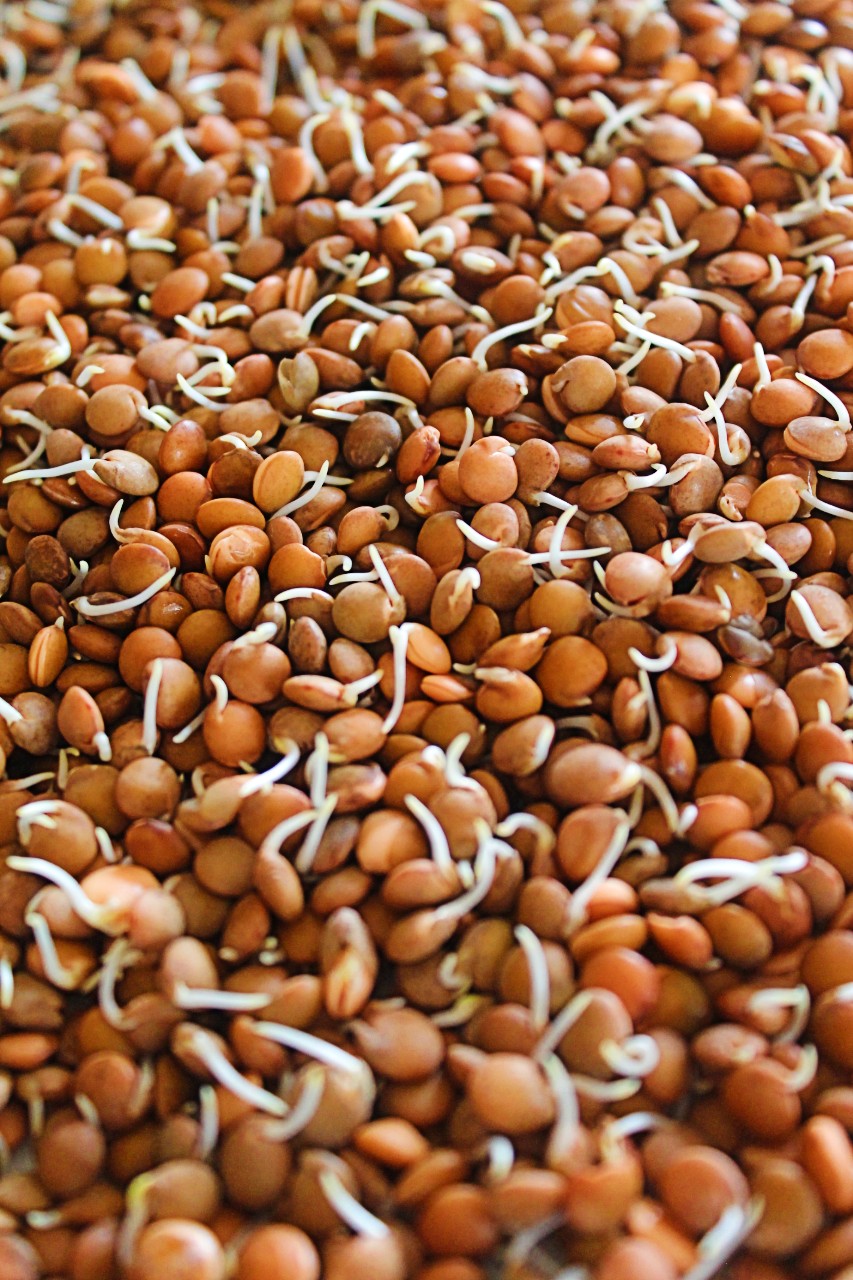
Good For Your Eyes
Sprouts are high in vitamin A, which is associated with improved vision. Thus, sprouts may help improve our vision and eyesight.
Heart Healthy
Sprouts are rich in omega-3 fatty acids, which help maintain good cholesterol (HDL) levels and reduce bad cholesterol (LDL) levels, which can cause clogged arteries.
Sprouting Guide
The following sprouting guide provides a glance at soaking and sprouting time for lentils and beans using traditional and Instant Pot methods.

How To Sprout Beans And Legumes
There are various ways of sprouting and also so many different foods that can be sprouted. Legumes, grains, seeds, and nuts can be sprouted.
Depending upon the size of the ingredient, the soaking and the sprouting time will vary. Please refer to the Sprouting Guide discussed earlier in this post. Here's a step-by-step process of sprouting beans and legumes traditionally and using an Instant Pot.
Step 1: Soaking
Rinse the beans thoroughly, and discard any stones, debris, or bad beans. Soak in water for 8-12 hours or overnight.
When beans rehydrate they almost double in size. I soak one cup of beans in 3 cups of water, thus making sure there is enough water for the beans to rehydrate.


Step 2: Drain And Rinse
After beans have been soaking for 8-12 hours, they must have been double in size. Drain and rinse the beans. Let excess water drain. This is important to avoid any mold formation.
Line a steamer basket or colander with a damp cloth or a cheesecloth. Add the soaked and drained beans to a steamer basket. Wrap the beans with a damp cloth.
Pic shown on left: You will notice that the well-soaked beans are doubled in size, are soft, and can easily break between the two fingers. Sometimes you will even notice tiny sprouts, sprouting through them.

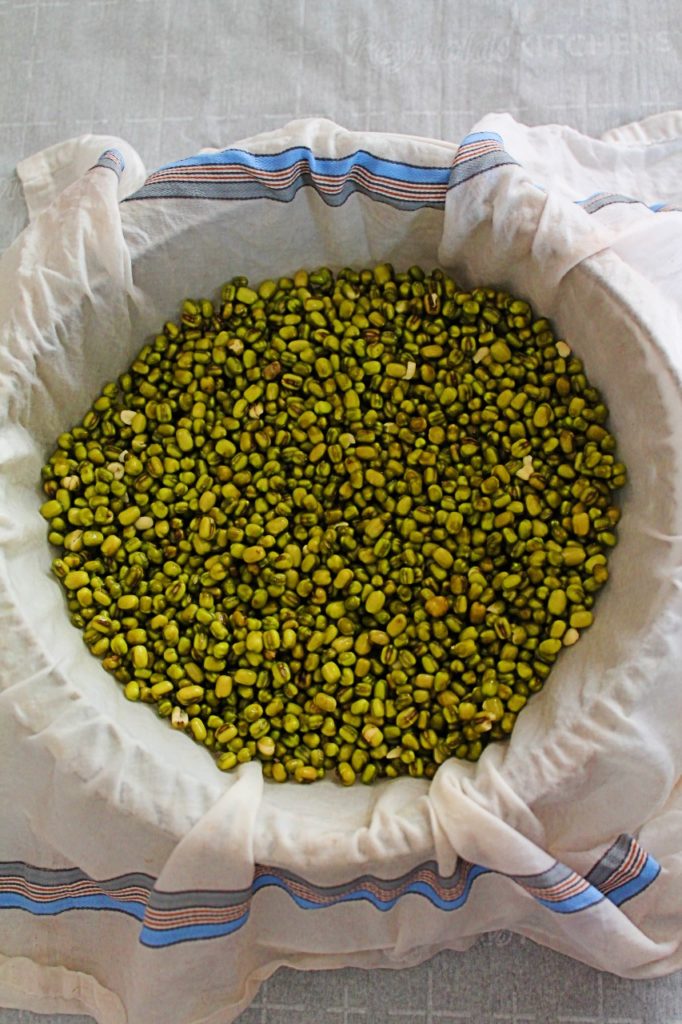
Step 3: Sprout Beans
Traditional Method: Cover the steamer basket with some plate and place it in a dry, warm place. I normally keep the steamer basket in the oven. No need to turn ON the oven. During winter, I leave the oven light ON, for some warmth.


Sprinkle some water once or twice to keep the sprouts moist, but NOT drenching.
Depending upon the moisture, and humidity in the temperature the sprouts will mature somewhere from 1 - 3 days. In the summers, it takes about a day for sprouts to mature.
In winter, it takes longer to sprout, therefore keep a close eye on the sprouts. They can start to turn moldy or slimy after a few days.
Depending upon how long you like the sprouts, you can leave the sprouts to grow for a longer time.
Pic shown: Sprouted mung beans for 12 hours.
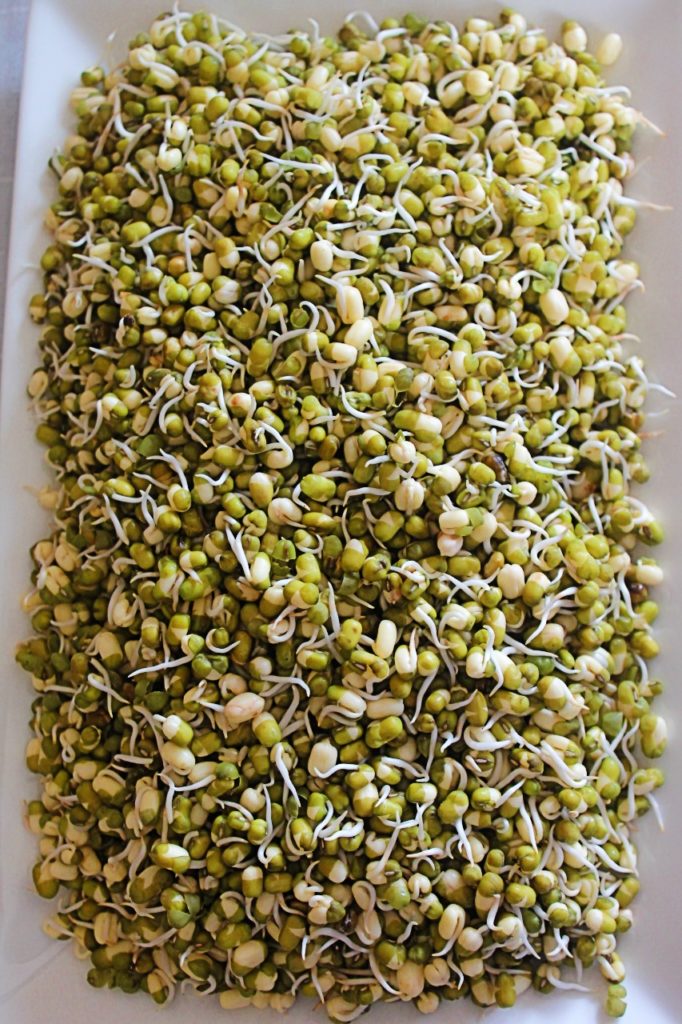
If using Instant Pot For Sprouting: Place a trivet in the inner pot of the Instant pot. Place a steamer basket on it. Wrap the beans with a damp cloth.
Remove the sealing ring and close the Instant pot lid in the venting position. You can also use a glass lid if you prefer.
Turn on the yogurt setting, by default it sets to 8 hours. Using the "+" option set the time to 12 hours.

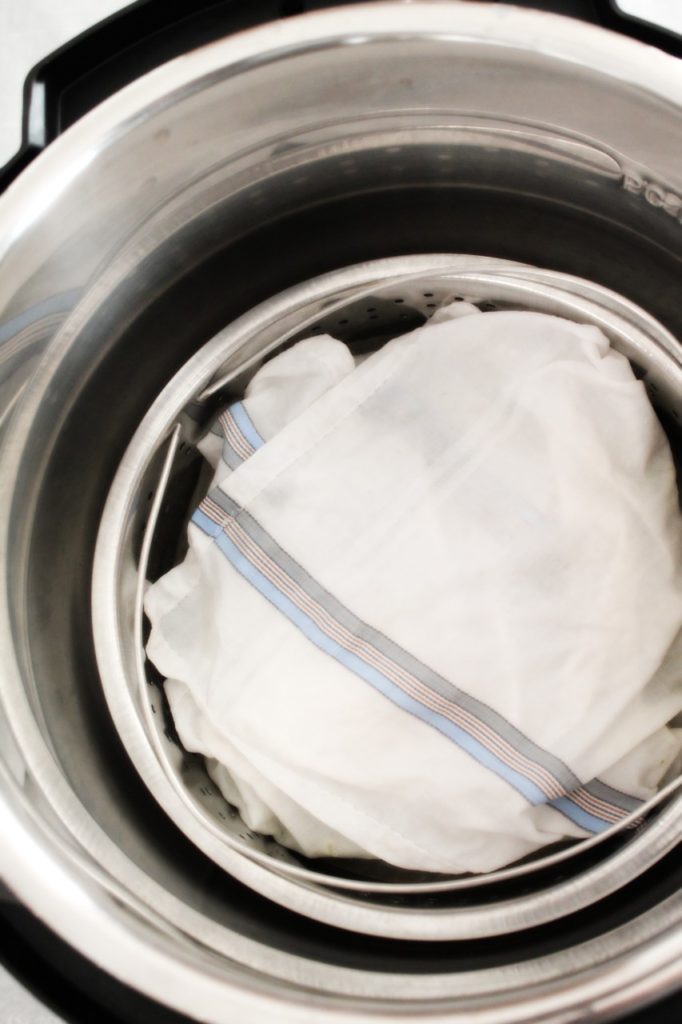
Step 4: Sprouts Are Ready
After 12 hours, check to see if the beans have sprouted. You will see beans have tiny sprouts coming out. If desired you can leave the sprouts in Instant Pot for a little longer, depending upon how long you like the sprouts.
If the cheesecloth seems dry, sprinkle some water. Check halfway through.
Pic shown: Sprouted mung beans, sprouting time 12 hours. You can keep it longer for longer sprouts.
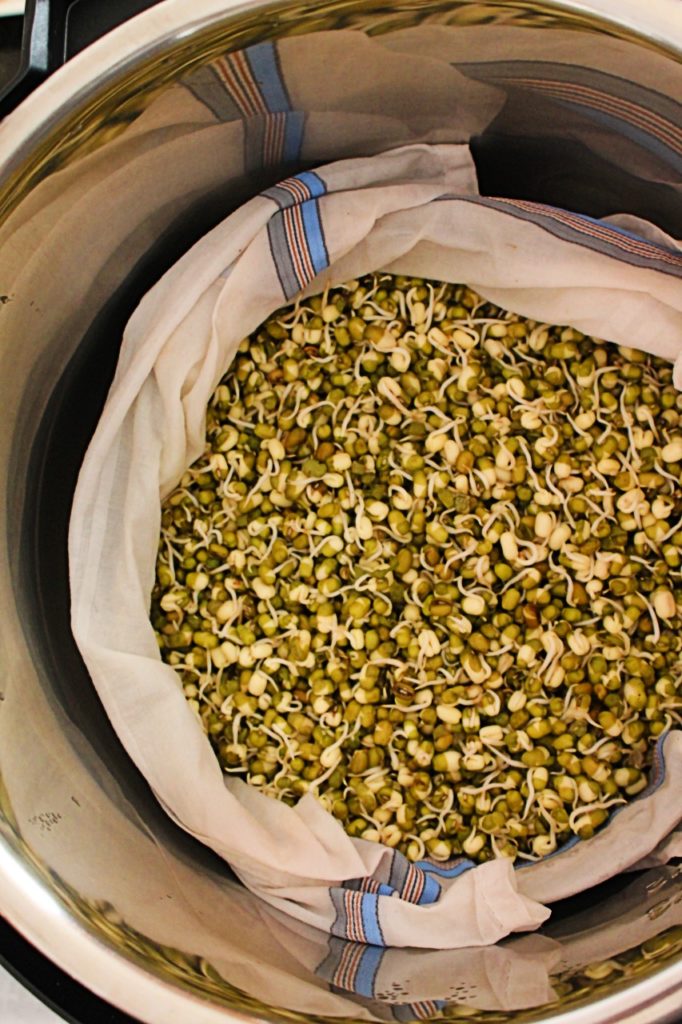
How To Properly Store Sprouts
Sprouts can be stored in a refrigerator for 3-5 days. Seed sprouts must be consumed within 1-2 days. Legumes, grains, and nuts can be stored for up to 5 days.
Store sprouts in a glass container, and layer kitchen paper towel. Do not pack the sprouts tightly. Change the paper towel, once every day for better results.
Rinse the sprouts daily for a longer shelf life. Dry them well, place a kitchen paper towel, and store them in the refrigerator.
Pic shown: Sprouted black-eyed beans, brown lentils, kidney beans, mung beans, chickpeas, and Moth beans. Sprouting time 8-36 hours.

Serving Suggestions
There are many ways to serve sprouts. Some of the ways we enjoy sprouts:
Sprouts Salad: Sprouts add a nice crunch to the salads. I prefer steamed sprouts in my salads. Drizzle some of your favorite dressing and the sprouts salad is ready to be devoured.
Sprouts Soup: I like to make sprout soup. A complete nourishing bowl of soup, serve with some crusty bread on the side for a complete meal.
Sprouts Appetizers: I like to serve sprouts as a chaat (Indian appetizer). Steam the sprouts, and add some yogurt dressing and some sweet and tangy tamarind chutney. Top it with some green chutney.
Sprouts Stir Fry: I like to stir-fry sprouts with some other vegetables.
Sprouts Curry: Make some sprouts curry, using some onion, tomatoes, and some Indian spices. Add sprouts and simmer until soft and tender. Enjoy sprouts curry as it is or with some steamed rice.
Pic shown: Sprouted Moth beans, sprouting time 8 hours. If kept longer for sprouting, they will grow longer sprouts.

Common Questions About Sprouting
What Food Can You Sprout?
Technically, any food that is whole and is not split or broken can be sprouted. However, there are limitations to what sprouts and what does not.
Legumes such as mung beans (moong), black chickpeas (kala chana), chickpeas (garbanzo beans), kidney beans, Moth beans, brown lentils (Masoor), soybeans, peas, and black-eyed beans.
Grains such as barley, wheat, corn, splat, rye, and rice can be sprouted.
Seeds such as quinoa, fenugreek, alfalfa, mustard, and radish.
Nuts such as peanuts and almonds can be sprouted.
How To Clean Sprouts?
Take a colander or a fine mesh sieve. Place the sprouts and run them under cold water for around 30-60 seconds. Gently, toss the sprouts a couple of times.
Let the colander sit on the counter for 5-10 minutes for all the excess water to drain. You can now use the sprouts as desired.
Why Do Sprouts Smell?
Sprouts contain living enzymes and therefore are at a high risk of contamination with some food bacteria.
The way you can tell if the sprouts have gone bad is first by their appearance. If sprouts look slimy or discolored.
Secondly, if they smell weird they have probably gone bad. Don't eat the sprouts!!
Do Sprouts Cause Abdominal Discomfort?
Certain sprouts such as broccoli, Brussels, cauliflower, cabbage, radish, and chickpeas, may cause stomach discomfort, blotting, or gas.
It is advisable to cook these sprouts first before consuming them. Sprouts when cooked are less likely to cause abdominal discomfort than raw ones.
Some sprouts such as Alfalfa can be eaten raw, as cooking these sprouts makes them mushy. Make sure to clean these sprouts thoroughly before consuming them.
Is It Important To Cook The Sprouts?
Sprouts contain living enzymes and are at a high risk of cross-contamination with some of the food-borne bacteria such as salmonella and E.coli. Cooking the sprouts eliminates this risk.
Sprouts can be steamed or boiled before consumption to prevent any food-borne illnesses.
Some spouts such as Alfalfa can be eaten raw, as cooking these sprouts makes them mushy. Make sure to clean these sprouts thoroughly before consuming them.
Pic shown: Sprouted chickpeas, kidney beans, black-eyed beans, sprouting time 24-36 hours.

Equipment
Cheesecloth: Cheesecloth, muslin cloth, or thin cotton cloth all work fine.
The important thing to remember is that the cloth should be damp and not wet.
The cloth gets stained once used for sprouting, therefore I prefer to keep it separate just for sprouting purposes only.
Colander: I have used the following steamer basket, colander, and fine mesh steamer for sprouting without the cheesecloth and they work the same.


The key thing to remember when sprouting without cheesecloth is to make sure to drain the water completely.
Whatever container you choose for sprouting, it should not retain water. Water retention can lead to mold formation.
Instant Pot (Optional): If you live in a cold climate, like I do. It takes 3-5 days for beans to sprout.
The instant pot comes in handy, especially during winter, it just speeds up the process of sprouting. It takes somewhere from 1-2 days to grow sprouts in an Instant pot. Thus, provides a warm and humid temperature, perfect for sprout legumes.
I don't add any water to the Instant Pot when I am using a damp cheesecloth for sprouting.
However, if you choose not to use the cloth and sprout the legumes directly into the steamer basket then add ¼ cup of water to the inner pot of the Instant pot. This will create a warm and humid atmosphere, required for sprouting.
Both techniques - with cheesecloth or without cheesecloth directly in the steamer basket work for sprouting.
Health Risks Associated With Sprouts
Sprouts contain living enzymes and are at a high risk of cross-contamination with some food-borne bacteria such as salmonella or E. coli.
To prevent this, keep your surroundings clean, including your kitchen and containers in which sprouts are stored. Always use clean hands to process the sprouts.
You must also cook the sprouts, lightly steam them, or boil them before consuming them.
Use organic seeds if possible for sprouting.
Consume sprouts within 3-5 days of sprouting for best results.
FAQ
Yes, sprouting is generally safe when done properly. Following recommended hygiene practices, using clean equipment, and selecting safe seeds or legumes for sprouting are important steps to ensure the safety of the sprouting process and the consumption of nutritious sprouts.
To prevent sprouts from getting moldy, ensure proper drainage by rinsing and draining them thoroughly at least twice a day. Additionally, maintain a clean environment, use quality seeds, and avoid overcrowding the sprouting container to allow for proper air circulation.
Yes, you can cook sprouts. Cooking sprouts can enhance their flavor, texture, and digestibility, making them a versatile ingredient in various dishes such as stir-fries, soups, salads, and wraps.
No, Canned beans have been cooked and processed and cannot be sprouted.

A Complete Guide To Sprouting Beans And Legumes
Ingredients
- 1 cup mung beans
- 3 cups water, for soaking
Instructions
- Rinse the beans thoroughly, and discard any stones, debris, bad or split beans. Soak in water for 12 hours or overnight.
- After beans have been soaking for 12 hours, they must have been double in size. Drain and rinse the beans. Let excess water drain. This is important to avoid any mold formation.
- Line a steamer basket or colander with a damp cloth or a cheesecloth. Add the soaked and drained beans to a steamer basket. Wrap the beans with a damp cloth.
Traditional Method:
- Cover the steamer basket with some plate and place it in a dry, warm place. I normally keep the steamer basket in the oven. No need to turn ON the oven. During winter, I leave the oven light ON, for some warmth.
- Sprinkle some water once or twice to keep the sprouts moist, but NOT drenching.
- Depending upon the moisture, and humidity in the temperature the sprouts will mature somewhere from 1 - 3 days. In the summers, it takes about a day for sprouts to mature. In winter, it takes longer to sprout, therefore keep a close eye on the sprouts. They can start to turn moldy or slimy after a few days.
Sprouting Using an Instant Pot:
- Place a trivet in the inner pot of the Instant pot. Place a steamer basket on it.
- Remove the sealing ring and close the Instant pot lid on venting position. You can also use a glass lid if you prefer.
- Turn on yogurt setting, by default it sets to 8 hours. Using “+” option set the time to 12 hours.
- After 12 hours, check to see if the beans have sprouted. You will see beans have tiny sprouts coming out.
- (Optional) If desired you can leave the sprouts in Instant Pot for little longer, depending upon how long you like the sprouts. If the cheesecloth seems dry, sprinkle some water. Check half way through.
Notes
- FAQ ABOUT SPROUTS
- SPROUTING GUIDE
- HOW TO SERVE SPROUTS

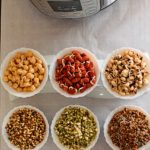








Stella says
I do not own a 'steamer' basket. Can I improvise?
Jyoti Behrani says
Hi Stella, You could use a colander or a strainer, would work fine. Please make sure that the container you use for sprouting does not retain water. Water retention can cause mold formation. Thanks!
Deval says
When using IP , Do you put water in the main steel pot ?
Jyoti Behrani says
Hi Deval, If using a damp cheesecloth, you don't need to add any water to the base. If the beans are placed directly on the steamer basket, without the cheesecloth, then you need to add 1/4 cup of water.Thanks!
Melodie says
Would this work for flowers like sweet peas?I should have started them earlier here in Oregon.
Jyoti Behrani says
Hi Melodie, Sorry, I have not tried sprouting with flower seeds in Instant Pot. Thanks!
zuni says
Hi! Thank you so much for this recipe! How long would I have to sprout black beans and yellow lentils?
Jyoti Behrani says
Hi, For black beans you can follow the same recipe. Is Yellow lentils same as split petite yellow lentils? If so, these won't sprout. For sprouting you need whole lentils, split won't work. Thanks!
Erin says
What if my instant pot doesn’t have the yogurt setting, can I still sprout them in the instant pot?
Jyoti Behrani says
Hi Erin, Sorry, I have not tried sprouting lentils in Instant pot using any other setting. But, I have also shared the traditional method for sprouting lentils. Thanks!
Vasanti says
What a great post! I followed your instructions diligently and had the most amazing sprouts! Thanks so much!!
Jyoti Behrani says
I am so glad you liked my recipe 🙂 Thanks for sharing your feedback!